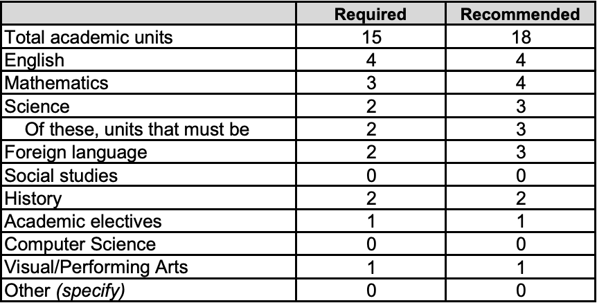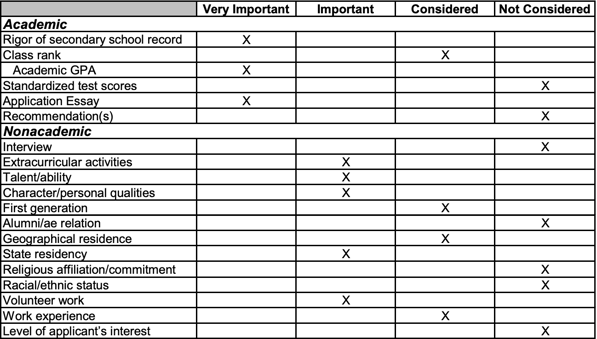University of California, San Diego (UCSD) Admissions Profile

Introduction
Welcome to our comprehensive guide on the UC San Diego admissions profile. If you're considering applying to UC San Diego, this article will provide you with all the essential information you need to know. From admission requirements to the application process, scholarships, and campus life, we've got you covered. Let's dive in and explore what makes UC San Diego such a prestigious institution.
UC San Diego Admissions Profile
UC San Diego is a renowned public research university located in La Jolla, California. Established in 1960, UC San Diego is known for its academic excellence, groundbreaking research, and commitment to innovation. With its diverse and collaborative community, UC San Diego offers a dynamic and enriching educational experience.
Distribution of high school units required and/or recommended

Relative importance of each of the following academic and nonacademic factors in your first-time, first-year, degree-seeking general (not including programs with specific criteria) admissions decisions.

Admissions Requirements
To gain admission to UC San Diego, applicants must meet certain requirements. Here are the key factors considered during the admissions process:
-
Academic Excellence: UC San Diego seeks students who have demonstrated academic excellence. This includes a challenging high school curriculum, strong grades, and a competitive GPA. Taking advanced courses, such as Advanced Placement (AP) or International Baccalaureate (IB), can enhance your application.
-
Test Scores: While UC San Diego takes a holistic approach to admissions, SAT or ACT scores play a significant role. It's recommended that applicants aim for scores within or above the middle 50% range of admitted students.
-
Transcripts and Coursework: Admissions officers review applicants' high school transcripts to assess their course selection, performance, and academic rigor. They also consider the specific courses related to the applicant's intended major or area of interest.
-
Personal Insight Essays: UC San Diego requires applicants to submit four personal insight essays that provide an opportunity to showcase their unique experiences, personal qualities, and aspirations. Craft thoughtful and compelling essays that highlight your strengths and reflect your passion and potential contributions to the UC San Diego community.
The Application Process
Applying to UC San Diego involves several steps, and it's important to stay organized throughout the process. Let's walk through each stage of the application process:
1. University of California Application
UC San Diego participates in the University of California Application system, which allows you to apply to multiple UC campuses simultaneously. Complete the application form accurately, including personal information, academic history, and extracurricular involvement.
2. Personal Insight Essays
As part of the application process, the University of California, San Diego (UCSD) requires applicants to complete supplemental essays. These essays provide an opportunity for applicants to showcase their unique qualities, experiences, and aspirations beyond what is captured in their general application. Let's explore the supplemental essays required by UCSD:
Personal Insight Questions
UCSD uses a set of Personal Insight Questions (PIQs) as their supplemental essays. Applicants are required to respond to four out of eight prompts, with a maximum of 350 words for each response. The PIQs aim to provide a comprehensive understanding of the applicant's background, experiences, and perspectives. The questions cover a wide range of topics, allowing applicants to share their personal stories, achievements, challenges, and potential contributions to the UCSD community.
The eight PIQ prompts are:
-
Describe an example of your leadership experience in which you have positively influenced others, helped resolve disputes, or contributed to group efforts over time.
-
Every person has a creative side, and it can be expressed in many ways: problem-solving, original and innovative thinking, and artistically, to name a few. Describe how you express your creative side.
-
What would you say is your greatest talent or skill? How have you developed and demonstrated that talent over time?
-
Describe how you have taken advantage of a significant educational opportunity or worked to overcome an educational barrier you have faced.
-
Describe the most significant challenge you have faced and the steps you have taken to overcome this challenge. How has this challenge affected your academic achievement?
-
Describe your favorite academic subject and explain how it has influenced you.
-
What have you done to make your school or community a better place?
-
Beyond what has already been shared in your application, what do you believe makes you stand out as a strong candidate for admissions to the University of California?
Applicants should choose the questions that allow them to highlight their unique experiences, perspectives, and achievements. It is crucial to provide specific examples and reflect on the impact of those experiences.
By carefully considering and thoughtfully responding to the Personal Insight Questions, applicants have the opportunity to present a holistic picture of their background, aspirations, and potential contributions to the UCSD community.
Sample UC Essays
Prompt: Describe an example of your leadership experience in which you have positively influenced others, helped resolve disputes, or contributed to group efforts over time.
Answer:
“CAPITALISM CAUSES EXTINCTION! NUCLEAR WAR IS IMMINENT!”
Initially, debate seemed nonsensical: lambasting opponents while arguing improbable scenarios. But over time I’ve learned that it’s more than competition that drives me to stay up all night looking for evidence: I love learning about the political and ideological underpinnings of our society and the way they shape us.
On an easy debate tournament weekend, I research foreign diplomatic agendas and synthesize the information into coherent debate evidence. When tournaments become more hectic, however, I delve deeper into the works of philosophers and social critics and translate the knowledge into debate argumentation. While researching foreign policy, critical theory like Heideggerian phenomenology and constitutional details, I’ve developed an ability to critically analyze argumentation, make sense of the world around me and creatively express myself in an academic setting.
My hard work has paid off. In the past four tournaments, I’ve received a Top 10 speaker award for the varsity division consisting of about 50 debaters. This trend has increased my credibility in my debate league to such a level that my partner and I were invited to participate in a series of public debates at LA City Hall to defend the water policy for the drought. The opportunity allowed me to actually impact the public’s awareness and accept a larger responsibility in the workings of my community.
More importantly, however, debate has taught me to strategically choose my battles. When I prepare my arguments, I know that I can’t use all of them in the end of a round. I have to focus. I’ve learned to maximize my strengths and not try to conquer everything. Moreover, I’ve learned to be responsible with my choices. A wrong argument can mean losing if we can’t defend well. Not only do I now know how to zoom in from a bigger picture, but I also know how to pick the right place to zoom in to so I can achieve my goal.
Debate has turned me into an responsible optimizing, scrutinizing and strategizing orator.
Prompt: Every person has a creative side, and it can be expressed in many ways: problem solving, original and innovative thinking, and artistically, to name a few. Describe how you express your creative side.
Answer:
Some people speak Chinese, others Spanish; I speak HTML. Language is intricately beautiful, with sentences flowing all within grammar constraints creating masterpiece bound by rules. If poetry in English can be considered art, so too can programming. Just as every sentence in English has a meaning and purpose, every line of code invokes a function.
Instead of communicating with people, coding is essentially having a conversation with computers, directing them onto what is desired. Unlike people, however, computers don’t have imagination, and therefore require users to be precise in every word and sentence they depict. Just as an artist expresses imagination with a pen, a programmer uses a keyboard.
Aside from being just a program, websites bring people closer together. Because Singapore is incredibly small, in order for my school to challenge its athletes, we have to go overseas to play against other schools. Forming a league called IASAS, schools visit each other and compete. The only issue with this is how expensive it is to travel, resulting in the teams flying without family or friends. Competitors often feel alone and unwelcome in the foreign school.
A website was the perfect solution for this: after much planning and deliberation, I formed a team to make a site where parents and friends could encourage their athletes! We started with brainstorming how to avoid cluttering the website and how best to keep it simple whilst connecting people together. Using flowcharts and diagrams, I used design principles to make it visually pleasing whilst maintaining structure and foundation. Focusing on supporting the athletes, guests were able to leave comments, get live scoring, and videos of the games.
The site allows parents and friends to encourage their students during some of the most significant tournaments of their high school careers. Creativity serves many functions, and mine intends to bring people closer together.
3. Letters of Recommendation
UC San Diego typically requires two letters of recommendation from teachers, counselors, or other individuals who can speak to your academic abilities, personal character, and potential for success at the university. Choose recommenders who know you well and can provide specific examples of your achievements and qualities.
4. Standardized Test Scores
UC San Diego follows a test-optional policy for undergraduate applicants. This means that submitting SAT or ACT scores is optional. However, strong test scores can still be beneficial for certain scholarships or specialized programs. Review the specific requirements for your desired major or program before deciding whether to submit scores.
5. Application Fee or Fee Waiver
There is an application fee to submit your application to UC San Diego. However, fee waivers are available for eligible students who demonstrate financial need. Check the UC San Diego admissions website for specific details and instructions on obtaining a fee waiver.
6. Deadlines
Understanding the application deadlines is crucial when applying to the University of California, San Diego. As part of the University of California (UC) system, UCSD follows the UC application timeline, which has specific deadlines for different application periods.
Fall Term Admission
For students seeking admission for the fall term, the application filing period opens on November 1 and closes on November 30. During this time, prospective students must submit their applications through the UC application portal.
Transfer Admission
Transfer students have a separate application filing period. For those aiming to transfer to UCSD for the fall term, the application filing period is from November 1 to November 30. During this time, transfer applicants must also submit their applications through the UC application portal.
Winter Quarter Admission
UCSB offers a limited number of undergraduate programs that admit students for the winter quarter. The application filing period for winter quarter admission is typically from July 1 to July 31.
Spring Quarter Admission
Similar to the winter quarter, UCSD also offers admission for a limited number of undergraduate programs for the spring quarter. The application filing period for spring quarter admission is typically from October 1 to October 31.
It's essential to note that the application filing period indicates the time frame during which prospective students can submit their applications. However, some programs or majors may have additional requirements or deadlines beyond the general filing period. It's crucial to review the specific requirements for the desired major or program to ensure compliance with any additional deadlines or materials.
Prospective students should also keep in mind that the UC application requires various components, such as the Personal Insight Questions, official transcripts, and test scores. It's essential to gather and submit all required materials by the specified deadlines to ensure a complete and timely application.
Scholarships and Financial Aid
UC San Diego is committed to providing access to education and offers various scholarships and financial aid options to assist students. Here are a few examples:
-
UC San Diego Scholarships: UC San Diego offers a range of merit-based scholarships to incoming students who demonstrate exceptional academic achievements, leadership qualities, or other outstanding accomplishments. These scholarships are awarded based on the overall strength of the applicant pool.
-
Financial Aid: UC San Diego's Financial Aid and Scholarships Office provides need-based financial aid to eligible students. By submitting the Free Application for Federal Student Aid (FAFSA) and the CSS Profile, students can be considered for grants, loans, work-study programs, and other forms of financial assistance.
-
External Scholarships: There are also external scholarship opportunities available to UC San Diego students. Research and apply for scholarships offered by organizations, foundations, and community groups that align with your interests and qualifications.
Campus Life and Resources
UC San Diego offers a vibrant campus life with a variety of resources and opportunities for students to engage in. Here are some highlights:
-
Academic Excellence: UC San Diego is renowned for its academic programs and research opportunities. With over 150 undergraduate majors and minors across various disciplines, students have the flexibility to explore their interests and pursue interdisciplinary studies.
-
Student Organizations and Activities: UC San Diego boasts a diverse array of student organizations, clubs, and extracurricular activities. Whether you're interested in academic clubs, cultural organizations, community service initiatives, or sports, there are numerous opportunities to get involved and make lasting connections.
-
Research and Internship Opportunities: UC San Diego is a leading research institution, providing undergraduate students with extensive research and internship opportunities. Students can collaborate with renowned faculty members, participate in groundbreaking research projects, and gain hands-on experience in their fields of interest.
-
Support Services: UC San Diego offers a range of support services, including academic advising, tutoring, counseling, and career development resources. Take advantage of these services to enhance your academic success, personal well-being, and career readiness.

Frequently Asked Questions
What is the acceptance rate at UCSD?
The acceptance rate for UC San Diego varies each year and depends on the applicant pool. It is generally competitive, with an average acceptance rate of around 30%.
Are interviews required for admission to UCSD?
What majors and programs are offered at UCSD?
UC San Diego offers a wide range of undergraduate majors and programs in areas such as arts and humanities, social sciences, natural sciences, engineering, business, and health sciences. Explore the UC San Diego website for a comprehensive list of available majors.
Conclusion
UC San Diego offers a remarkable educational experience with its commitment to academic excellence, research, and innovation. By understanding the UC San Diego admissions profile, you can navigate the application process with confidence. Best of luck as you embark on this exciting journey toward a future filled with academic growth and personal development!
